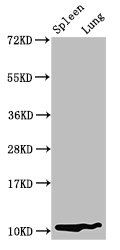S100a8 Antibody
-
货号:CSB-PA020641LA01RA
-
规格:¥440
-
促销:
-
图片:
-
其他:
产品详情
-
产品名称:Rabbit anti-Rattus norvegicus (Rat) S100a8 Polyclonal antibody
-
Uniprot No.:P50115
-
基因名:
-
别名:S100a8 antibody; Mrp8 antibody; Protein S100-A8 antibody; Calgranulin-A antibody; Migration inhibitory factor-related protein 8 antibody; MRP-8 antibody; p8 antibody; S100 calcium-binding protein A8 antibody
-
宿主:Rabbit
-
反应种属:Rat
-
免疫原:Recombinant Rat Protein S100-A8 protein (2-89AA)
-
免疫原种属:Rattus norvegicus (Rat)
-
标记方式:Non-conjugated
本页面中的产品,S100a8 Antibody (CSB-PA020641LA01RA),的标记方式是Non-conjugated。对于S100a8 Antibody,我们还提供其他标记。见下表:
-
克隆类型:Polyclonal
-
抗体亚型:IgG
-
纯化方式:>95%, Protein G purified
-
浓度:It differs from different batches. Please contact us to confirm it.
-
保存缓冲液:Preservative: 0.03% Proclin 300
Constituents: 50% Glycerol, 0.01M PBS, PH 7.4 -
产品提供形式:Liquid
-
应用范围:ELISA, WB
-
推荐稀释比:
Application Recommended Dilution WB 1:500-1:5000 -
Protocols:
-
储存条件:Upon receipt, store at -20°C or -80°C. Avoid repeated freeze.
-
货期:Basically, we can dispatch the products out in 1-3 working days after receiving your orders. Delivery time maybe differs from different purchasing way or location, please kindly consult your local distributors for specific delivery time.
相关产品
靶点详情
-
功能:S100A8 is a calcium- and zinc-binding protein which plays a prominent role in the regulation of inflammatory processes and immune response. It can induce neutrophil chemotaxis and adhesion. Predominantly found as calprotectin (S100A8/A9) which has a wide plethora of intra- and extracellular functions. The intracellular functions include: facilitating leukocyte arachidonic acid trafficking and metabolism, modulation of the tubulin-dependent cytoskeleton during migration of phagocytes and activation of the neutrophilic NADPH-oxidase. Activates NADPH-oxidase by facilitating the enzyme complex assembly at the cell membrane, transferring arachidonic acid, an essential cofactor, to the enzyme complex and S100A8 contributes to the enzyme assembly by directly binding to NCF2/P67PHOX. The extracellular functions involve proinflammatory, antimicrobial, oxidant-scavenging and apoptosis-inducing activities. Its proinflammatory activity includes recruitment of leukocytes, promotion of cytokine and chemokine production, and regulation of leukocyte adhesion and migration. Acts as an alarmin or a danger associated molecular pattern (DAMP) molecule and stimulates innate immune cells via binding to pattern recognition receptors such as Toll-like receptor 4 (TLR4) and receptor for advanced glycation endproducts (AGER). Binding to TLR4 and AGER activates the MAP-kinase and NF-kappa-B signaling pathways resulting in the amplification of the proinflammatory cascade. Has antimicrobial activity towards bacteria and fungi and exerts its antimicrobial activity probably via chelation of Zn(2+) which is essential for microbial growth. Can induce cell death via autophagy and apoptosis and this occurs through the cross-talk of mitochondria and lysosomes via reactive oxygen species (ROS) and the process involves BNIP3. Can regulate neutrophil number and apoptosis by an anti-apoptotic effect; regulates cell survival via ITGAM/ITGB and TLR4 and a signaling mechanism involving MEK-ERK. Its role as an oxidant scavenger has a protective role in preventing exaggerated tissue damage by scavenging oxidants. The iNOS-S100A8/A9 transnitrosylase complex is proposed to direct selective inflammatory stimulus-dependent S-nitrosylation of multiple targets such as GAPDH, ANXA5, EZR, MSN and VIM by recognizing a [IL]-x-C-x-x-[DE] motif; S100A8 seems to contribute to S-nitrosylation site selectivity.
-
基因功能参考文献:
- Establish S100A8 transgenic rats to elucidate role as a regulator in acute inflammation. PMID: 28913572
- Recombinant rat r-S100A8 bound to r-CD68. The expression levels of S100A8 were significantly suppressed after the macrophages had been treated with an anti-CD68 antibody. Small interfering CD68 also significantly suppressed activation of macrophages through an autocrine pathway by r-S100A8. PMID: 27312849
- results support S100A8 as a novel therapeutic target to control ASM contraction in asthma PMID: 28088518
- vagus nerve electrical stimulation may produce a protective effect on septic shock in rats by decreasing the production of S100A8. PMID: 27035526
- Expression of S100A8 mRNA and the corresponding protein in cultured NRVCs was similar between control cells and norepinephrine-stimulated cells, but was markedly upregulated at 12 hours after the withdrawal of NE. PMID: 25820336
- Mrp8 may potentiate the perpetuation of mesial temporal lobe epilepsy by activating the NF-kappaB pathway in astrocytes. PMID: 23982744
- Report role for MRP8 for exaggerated in-stent restenosis in diabetes mellitus type 2. PMID: 22381691
- In vivo zinc regulates S100A8 expression and modulates the link between S100A8-RAGE interaction and downstream nuclear factor kappaBeta/COX-2 signaling PMID: 19111725
- The bladder uroepithelium was a prominent cell source of S100A8-S100A9 in animals with complicated urinary tract infection, which was not detected in animals with asymptomatic urinary tract infection. PMID: 19667050
显示更多
收起更多
-
亚细胞定位:Secreted. Cytoplasm. Cytoplasm, cytoskeleton. Cell membrane; Peripheral membrane protein.
-
蛋白家族:S-100 family
-
数据库链接:
KEGG: rno:116547
STRING: 10116.ENSRNOP00000015473
UniGene: Rn.31839
Most popular with customers
-
-
YWHAB Recombinant Monoclonal Antibody
Applications: ELISA, WB, IF, FC
Species Reactivity: Human, Mouse, Rat
-
Phospho-YAP1 (S127) Recombinant Monoclonal Antibody
Applications: ELISA, WB, IHC
Species Reactivity: Human
-
-
-
-
-






















